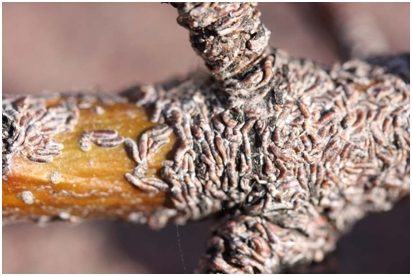This insect has become a major issue in Calgary over the past number of years. Oystershell scale is hardly recognizable as an insect. On close inspection it looks like a tiny oyster shell. It is one species of a group called armoured scales. Oystershell scale can attack fruit trees, lilacs, ash and elm but in Calgary these scales are most likely to be found on cotoneaster hedges although in recent years it has started to spread to many alternate species. Scales may cover affected stems to the point that the stem appears to merely have rough bark. A quick scratch with a fingernail will reveal the bark underneath and you realize the extent of the infestation.
Oystershell scales begin life as over wintering eggs under the shells of their now dead mothers. After hatching in spring, the small white crawlers emerge and move a short distance. They insert their sucking mouth parts into the stem to feed on plant juices and secrete a protective shell. Crawlers are easily blown to other stems or plants by the wind. Or transported on tools used by landscapers to prune and shape hedges.
Key Points
- This insect is most common on Cotoneaster shrubs.
- Chemical sprays are only effective on one stage of the insect (crawler stage).
- Damage shows as dieback of large stems or in patches of the crown.
- Pruning out affected stems or cutting the entire hedge to ground level combined with pesticide treatment is the most effective control.
- Keep your hedge healthy by having it “thinned out” to allow air and light to penetrate the canopy.
- Avoid constant pruning and allow hedges to grow out a bit each year. Constantly removing new growth will stress the plant and make it more susceptible to insects
Tree Damage
Dead patches within a hedge including dry brown leaves are the usual sign of oystershell scale feeding. By the time this becomes alarming the scales have covered most of the affected branches.
When this insect is found on trees, it can cause premature yellowing and dropping of leaves and thin canopies overall. As the insect progresses, whole branches will begin to die, beginning in the lower crown and moving their way up.
Control Measures
- Chemical sprays are effective only on the crawler stage in the early Spring. Especially with Cotoneaster, pesticide spray may be the only effective control.
- Horticultural oils may be effective in suffocating eggs if applied before the tree or shrub leafs out, and where the infestation has not progressed too far however they don’t tend to get the desired amount control even when used annually.
- Pruning out affected stems or cutting the entire hedge to ground level is the most effective control once dead patches have become evident in a cotoneaster hedge. Cotoneaster with healthy root systems will quickly re-grow. Within a few years, a hedge may be a couple of feet tall again. New growth must be monitored for the inevitable return of the insect and then treatment with pesticide spray or horticultural oil will be effective in controlling the insect.


